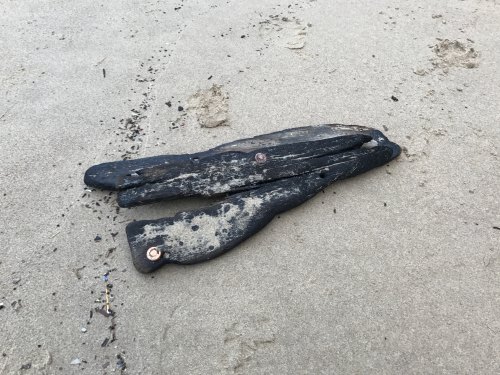
Image use policy
Our images can be used under a CC BY attribution licence (unless stated otherwise).
SHIPS TIMBER
Unique ID: MAS-O100026
Object type certainty: Probably
Workflow
status: Published ![]()
Two fragments of waterlogged wood with two copper fasteners dating from the post-medieval period onwards.
The wood may be the remains of two planks of wood used in the construction of a ship as the planks are secured with one copper fastening and a hole is visible where another fastening may have also been used. Copper rivets are the standard method of fastening the planks to each other in clinker constructed vessels, or in the planks to the ribs or frames (Traditional Maritime Skills website, accessed September 2017). Clinker is a method of constructing the hull of a boat by fixing wooden planks so that the planks overlap along their edges. The overlapping joint is called a land. If the plank is too short for the hull, it would be necessary to extend the plank by joining with another piece of wood. Planks are also known as strakes (rubbing strake for example) so this method is also known as lapstrake. It is a very traditional method of ship construction.
Metallic fastenings followed on from tree nails (also commonly known as trunnels and trennels), which were an older method of securing two planks together using wooden 'nails'.
Class:
TRANSPORT
Sub class: VESSEL COMPONENT
Subsequent actions
Current location of find: With finder
Subsequent action after recording: Submitted as wreck to the Receiver of Wreck
Wreck details
Droit number: 008/17
Chronology
Broad period: NINETEENTH CENTURY
Period from: POST MEDIEVAL
Period to: MODERN
Dimensions and weight
Quantity: 2
Discovery dates
Date(s) of discovery: Saturday 28th January 2017
Personal details
Found by: This information is restricted for your login.
Recorded by: L R
Identified by: L R
Secondary identifier: V L
Other reference numbers
Droit ID: 008/17
Materials and construction
Spatial coordinates
4 Figure: NZ6721
Four figure Latitude: 54.57977665
Four figure longitude: -0.96494213
1:25K map: NZ6721
1:10K map: NZ62SE
Display four figure position on What3Words
Grid reference source: From finder
Unmasked grid reference accurate to a 1 metre square.
References cited
No references cited so far.
Similar objects

Find number: MAS-F100107
Object type: TRANSPORT
Broadperiod: POST MEDIEVAL
This ship's timber is 830 mm long, 110 x 120 mm in profile, with truncated 25 mm diameter treenails; and a 385 x 65 mm slot for the supporting…
Workflow: Published![]()

Find number: MAS-D100128
Object type: HINGE
Broadperiod: NINETEENTH CENTURY
This record refers to the metal hinge and attached timber shown in the top left corner of image one, the other finds are dealt with under sepa…
Workflow: Published![]()




